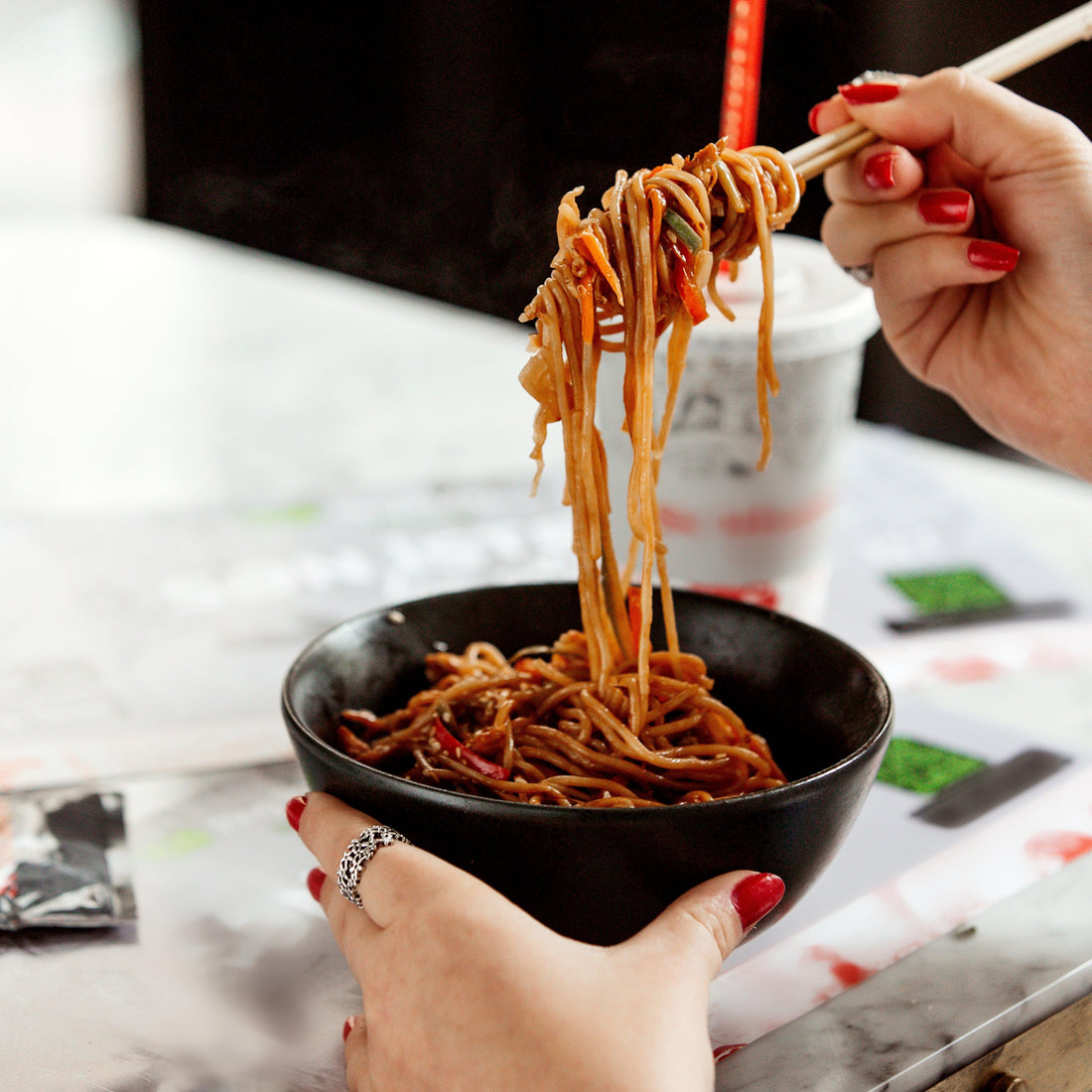Imagine this. It’s a hot summer day, you’ve just finished work, and you’re starting to get hungry. Something cold and refreshing sounds nice, but you’d also like some dinner that has a certain… kick to it. Enter bibimmyeon, 비빔면 (pronounced like it looks). If you’ve shied away from making Korean food in the past, let this serve as an excuse to finally cook some!
This cold, spicy noodle dish has been an absolute favorite in Korea for decades, but it is just making its way to the United States. Let’s dive into the history, ingredients, and preparation of this classic Korean dish.
What is Bibimmyeon?
Cold noodle dishes are common in many different parts of the world. Italian-inspired pasta salads are typically served below room temperature and are a Western equivalent of bibimmyeon in some respects.
At its core, bibimmyeon is two syllables meaning two different things. First, bibim, roughly meaning “mix.” Then we have “myeon,” roughly meaning “noodles.” Thus, put them together, we get “mixed noodles.” But, that doesn’t tell the whole story.
Two parts of bibimmyeon make it distinct. First: cold noodles. As we’ll discuss, there are a few tricks to correctly cooking and cooling the noodles. Secondly: the sauce. While there is a wide range of spices and ingredients that could be used to technically count as bibimmyeon, there are ingredients that are more traditional and typical of the dish.
Sure, instant noodles are popular and easy to make, but cooking bibimmyeon from scratch isn’t hard, and it allows you to play with the flavors and spice levels to get the exact dish that you want.
Essential Ingredients
Every good bibimmyeon draws from the well of tried and true ingredients that give it a similar cold-but-spicy kick.
Ramen Noodles
Any ramen noodles will do, really. There are loads of different kinds that each have unique flavors and spices. You’ll want to pick one that is on the mild side if you’d like to have more control over what the final product will taste like. You’re shooting for about four ounces per person.
Sauce
Like a traditional red pasta sauce, there are hundreds and hundreds of different recipes for bibimmyeon sauce. They will differ in their exact proportions and styles, but they all have three common elements: heat, sweet, acid.
The heat typically comes from gochujang, an absurdly good red chili paste that will put the Siracha in your cupboard to shame. The sweet is typically sugar, but the exact type of sugar (refined, unrefined, brown, etc) may differ. Last, the acid is almost always derived form some form of vinegar.
Condiments
Bibimmyeon toppings are where the recipes really start to differ. You can think of these condiments kind of like toppings on a classic American burger. Cheese, onions, pickles, tomatoes, bacon, ketchup, mustard… Everyone has a preference, you’ll have to figure out what the best bibimmyeon for you is. Common toppings include cucumber, sesame seeds, lettuce, or hard-boiled egg. While they’re not technically toppings, many people enjoy kimchi or rice cakes as a side dish with their bibimmyeon.
Recipe
Finally, recipe time! Prep time is only about 15 minutes if you include the noodle and egg preparation.
Noodles
- 20 ounces of ramen noodles. Any ramen noodles found at your local grocery store should do the trick. In a pinch, soba or udon noodles would also suffice.
Bibimmyeon Spicy Sauce
- 6 tbsp Gochujang paste
- 4 tbsp Soy Sauce
- 6 tbsp sugar
- 2 tsp The Happy Ms. Jungeun Fresh Sesame Oil
- 2 tsp black pepper
- 1 tbsp apple cider vinegar
- 2 tsp Worcestershire sauce
- Red pepper flakes
Bibimmyeon Toppings
- 4 hard-boiled eggs
- 1 cucumber, sliced thinly
- Sesame seeds
Preparation
- Get your eggs hard-boiled. This will take about 10 minutes, which gives you time to cut the cucumber and mix all the sauce ingredients together. Set sauce aside in fridge.
- Cook ramen noodles according to package noodle instructions. Typically, this is a few minutes in boiling water. Continually try the noodles as they’re cooking - you’re aiming for chewy but soft.
- As soon as the noodles are cooked, wash them with cold water! This stops the cooking process. If left and let stand, the noodles will likely become a gross, mushy mess.
- Remove sauce from fridge and toss with cold noodles. Top with egg and cucumber (or other desired toppings) and enjoy!
For more great recipes, check out Kim’C Market’s Recipe Hub!
Hero image by KamranAydinov.
Keywords: South Korea, korean food, korean recipes, bibimmyeon. noodles


